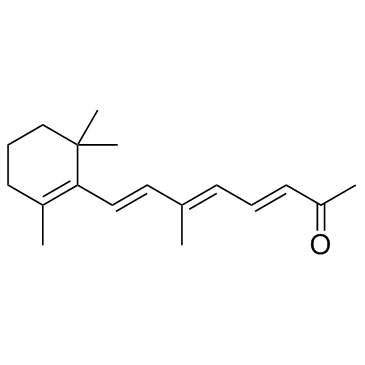β-Apo-13-carotenone (D'Orenone) (Synonyms: D'Orenone) |
| Catalog No.GC33470 |
&베타;-아포-13-카로테논(D'오레논)(D'오레논)은 자연 발생 β입니다.
Products are for research use only. Not for human use. We do not sell to patients.

Cas No.: 17974-57-1
Sample solution is provided at 25 µL, 10mM.
β-Apo-13-carotenone (D'Orenone) is a naturally occurring β-apocarotenoid functioned as an antagonist of RXRα.
β-apo-13-Carotenone is identified as enzymatic cleavage products of β-carotene in homogenates of intestinal mucosa of rat. β-apo-13-carotenone is found to antagonize the activation of RXRα by 9-cis-retinoic acid and is effective at concentrations as low as 1nM. Molecular modeling studies reveal that β-apo-13-carotenone makes molecular interactions like an antagonist of RXRα[1]. β-apo-13-carotenone competes for 9cRA binding to RXRα with an affinity (7-8 nM) identical to 9cRA itself. β-apo-13-carotenone antagonizes 9cRA activation of full-length hRXRα with a similar efficiency as the known antagonist UVI3003. β-apo-13-carotenone induces formation of the RXRα transcriptionally silent tetramer but does not inhibit coactivator recruitment to the isolated LBD[2]. The uptake and/or metabolism of β-apo-13-carotenone does not allow for accumulation of these β-carotene metabolites in cells. 3T3-L1 adipocyte marker gene expression is induced by β-apo-carotenoid treatment[3].
[1]. Eroglu A, et al. The eccentric cleavage product of β-carotene, β-apo-13-carotenone, functions as an antagonist of RXRα. Arch Biochem Biophys. 2010 Dec 1;504(1):11-6. [2]. Sun J, et al. β-Apo-13-carotenone regulates retinoid X receptor transcriptional activity through tetramerization of the receptor. J Biol Chem. 2014 Nov 28;289(48):33118-24. [3]. Wang CX, et al. Actions of β-apo-carotenoids in differentiating cells: differential effects in P19 cells and 3T3-L1 adipocytes. Arch Biochem Biophys. 2015 Apr 15;572:2-10.
Average Rating: 5 (Based on Reviews and 3 reference(s) in Google Scholar.)
GLPBIO products are for RESEARCH USE ONLY. Please make sure your review or question is research based.
Required fields are marked with *




















